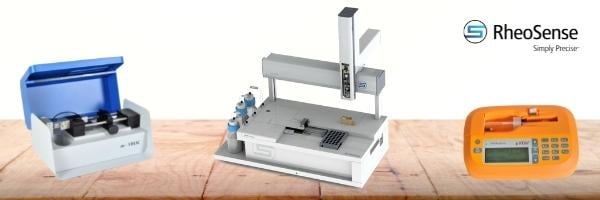Dry eye, a medical condition that is associated with a lack of lubrication on the eye surface, is a chronic problem for many people. According to The American Academy of Ophthalmology, "An estimated 3.2 million women age 50 and over and 1.68 million men age 50 and over are affected by dry eye syndrome." There is a variety of both over-the-counter and prescription eye drops formulated to treat dry eye symptoms on the market today. Each different eye drop or brand has it's own unique formulation and different major formulation component(s).
.png?width=500&name=Eye%20Drop%20(blank).png)
Viscosity is one essential parameter to factor in when formulating eye drops. Viscosity and its shear rate dependence directly impact the performance of eye drops formulated for the relief of dry eye. One formulation approach to eye drops is to develop shear thinning solutions (viscosity decreases as the shear rate increases) consisting of either water-soluble polymers or oil in water emulsions. These solutions are designed to provide optimal performance from the initial point of insertion and throughout the blink cycle, which involves a broad range of shear rates.
Overall performance of eye drops is not just dependent on the formulation. The environment after the eye drops are inserted will also have a major impact on the performance. The motion of the eyelid during the blink cycle will shear the tear film fluid which has been modified by the addition of the eye drops. For dry eye drops to provide any benefit, an adequate amount of product must remain in the eye.

Because of the environment of the eye throughout the blink cycle, shear rates are important for eye drops. Eyelid movements induce high shear rates. The shear rates from closing and opening eyelids vary from 4000 to 20000 1/s. An eye drop viscosity approaching that of normal tears at these shear rates helps prevent the user experiencing blurring and noticeable discomfort during blinking (Centre for Industrial Rheology). Measuring the viscosity of eye drops at high shear rate is very important to understand and formulate for the shearing caused by the eyes natural blink cycles. Knowing the formulation viscosity in this regime is crucial to predicting performance of eye drops.
Consequences of not knowing viscosity as you formulate your dry eye drops include:
- Disproportionate distribution of formulation over the eye
- Eye drop formulation that cannot withstand the average blink cycle
- Poor customer experience caused by lack of dry eye relief
These consequences can result in poor product performance, a negative customer experience and can even lead to long term negative impacts for the user such as worsened dry eye or chronic dry eye if the eye drops fail.
Download our Eye Drop e-Book for a complete guide to understanding the importance of viscosity and its shear rate dependence on the performance of eye drops formulated for the relief of dry eye.
Conventional rheometry tools, due to their shear rate limitations, are difficult to use for eye drop viscosity measurements. RheoSense VROC® viscometers are designed for high shear measurements, making them ideal for measuring viscosity of eye drops. RheoSense instruments have been rigorously tested, approved, and adopted worldwide by Fortune Global 500 companies and leading research universities.
Contact us to learn more about our VROC viscometers or schedule a FREE demo to see for yourself how they can directly benefit your eye drop formulation.
Written by: Eden Reid, RheoSense Senior Marketing and Sales Operations





COMMENTS